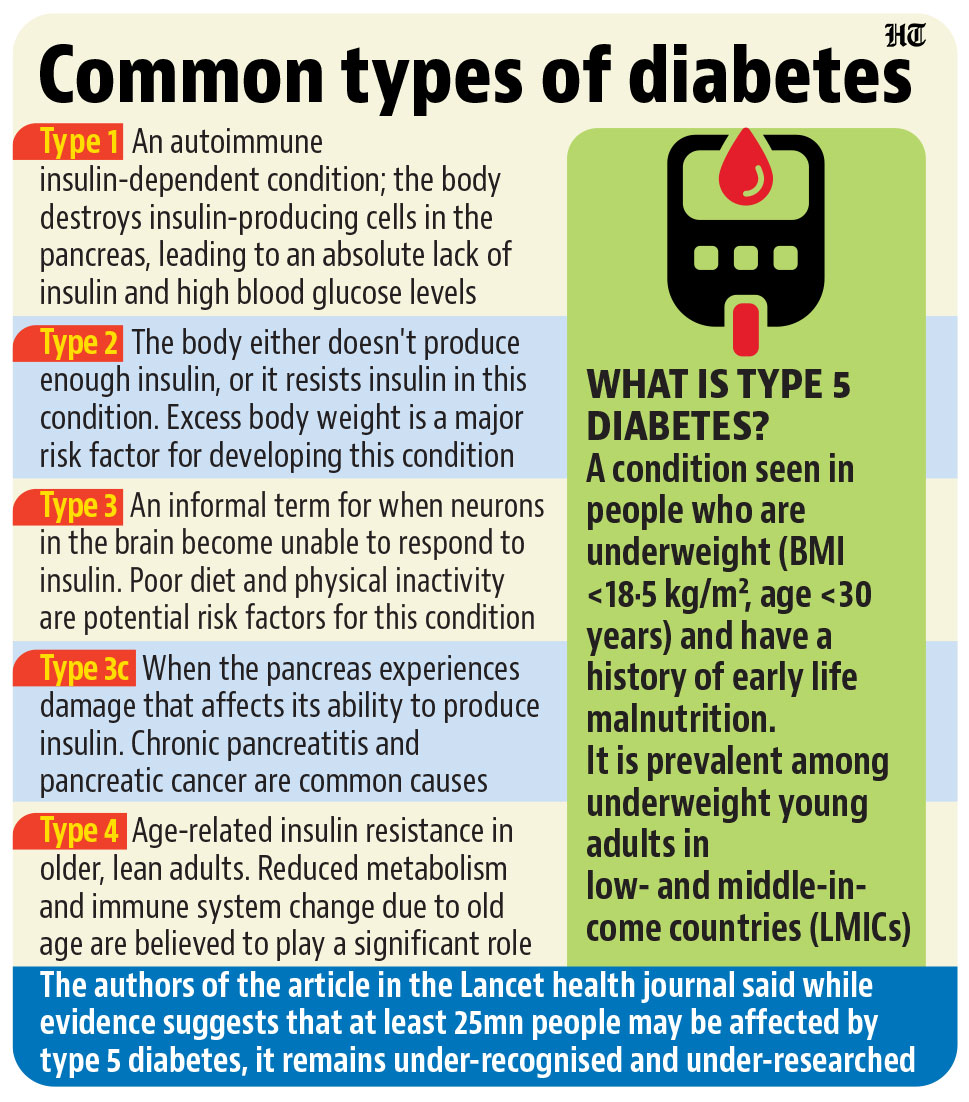Experts seek formal classification of ‘type 5’ diabetes, advanced research
While evidence suggests that at least 25 million people may be affected by type 5 diabetes, the authors said it remains under-recognised and under-researched
distinct but little known form of diabetes prevalent among millions of underweight young adults in low- and middle-income countries (LMICs) should be formally recognised as ‘type 5’ diabetes, experts have proposed.

The proposal, called the Vellore Declaration, was recently formalised at the International Diabetes Federation’s (IDF) World Diabetes Congress in April 2025, and is outlined in an article published in the Lancet Global Health journal. The name follows a consensus meeting in Vellore, Tamil Nadu, in January, 2025, where type 5 diabetes was proposed as the nomenclature for this distinct form of diabetes.

As well as the well-known type 1 (autoimmune, insulin-dependent) and type 2 (weight-related) diabetes, other forms of diabetes also exist . They are informally referred to as type 3 (occurs when neurons in the brain become unable to respond to insulin), type 3c (when the pancreas experiences damage that affects its ability to produce insulin), and type 4 diabetes (age-related insulin resistance in older, lean adults).
“We call upon the international diabetes community to recognise this distinct form of the disease, and to support the IDF’s Type 5 Diabetes Working Group…,” said the authors.
Diabetes is associated with an increasing public health burden worldwide, and the number of people living with the disease is expected to increase markedly in LMICs, which are facing a double burden of undernutrition and overnutrition.
According to The Lancet journal, type 5 diabetes was first described in 1955 as a condition seen in people who are underweight (BMI <18·5 kg/m², age <30 years), and have a history of early life malnutrition. It was formally classified by the World Health Organization (WHO) in 1985 as “malnutrition-related diabetes mellitus”. It was removed from the list of diabetes types in 1999 due to disagreement as to whether undernutrition was a sufficient risk factor to cause this type of diabetes.
However, the authors of the Lancet article said that decades of research using modern techniques now show these patients have distinct symptoms compared to type 1 and type 2 diabetes.
“For example, people with type 5 diabetes don’t produce enough insulin, but their body still processes insulin normally. They also typically do not experience ketoacidosis (sudden onset of illness common in type 1 diabetes) and their immune systems do not attack the pancreas,” they said in the article.
While evidence suggests that at least 25 million people may be affected by type 5 diabetes, the authors said it remains under-recognised and under-researched, which has led to misdiagnosis, underreporting, and a lack of evidence-based treatment guidelines, potentially harming patient care.
“…insufficient evidence for this form of diabetes makes it challenging to define diagnostic criteria and risk factors that are applicable to diverse populations. This form might be misdiagnosed due to diagnostic overlap with other atypical diabetes forms…especially in resource-limited settings, leading to under-reporting of this form of diabetes and a continued diagnostic neglect in global research and policy agendas,” said the authors.
They added that the IDF aims to change this with the formation of a new working group to develop formal diagnostic criteria and encouraging research into its traits, natural history, and treatment, for the benefit of millions of patients worldwide, particularly in LMICs.
“Emerging evidence now strongly supports the distinct classification of this unique diabetes phenotype, which is characterised by substantial impairment of pancreatic insulin secretion, with normal hepatic and peripheral insulin sensitivity, an absence of ketoacidosis, and no islet cell autoantibodies. In this consensus statement, we synthesise this evidence to produce a set of common features of the disease, proposed pathogenetic mechanisms, and suggested management and prevention strategies,” the authors added.
A section of experts, however, said that classifying type 5 as a separate category would be jumping the gun.
“It’s premature to classify it as a separate category with the kind of evidence we have on hand at the moment and also with type 3 and 4 yet not fully understood. We need to study it more. Even if the entity is established, type 1 and type 2 will continue to remain a much bigger health concern,” said Dr Ambrish Mithal, chairman and head of endocrinology and diabetes, Max Healthcare.







